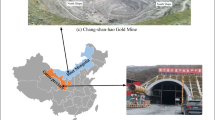Abstract
The point load test is widely used as an index test for determining the rock material strength and classification. The test provides an overall measure of rock strength known as the point load strength index (Is). In the standard method, the minimum cross-sectional area (A) of a plane through the platen contact points is considered, and its equivalent core diameter is used to determine Is. This paper suggests that the equivalent diameter of the specimen is calculated considering the actual area of the failure plane (A*) recognized after the test. Accordingly, the relationships used for PLI calculation were updated. A number of blocks and irregular lumps were subjected to the point load test. The dimensions were measured once by a steel ruler and once using an image-processing technique. The results revealed that there is a strong positive correlation between the failure load (P) and A*, while the correlation between P and A is weak and insignificant. Hence, A* is a better parameter to normalize P and to yield a strength index (\({I}_{s}^{*}\)). Statistical analyses proved that the \({I}_{s}^{*}\) values have less dispersion around the mean and are more normally distributed compared to the Is values. Therefore, \({I}_{s}^{*}\) regardless of the tool used to measure dimensions, seems a more reliable index.







Similar content being viewed by others
References
ASTM (2008) Standard test method for determination of the point load strength index of rock and application to rock strength classifications. ASTM International, West Conshohocken, PA, USA
ASTM (2001) Standard method for determination of the point load strength index of rock, Designation. ASTM International, West Conshohocken, PA, USA
Basu A, Aydin A (2006) Predicting uniaxial compressive strength by point load test: significance of cone penetration. Rock Mech Rock Eng 39:483–490
Bieniawski ZT (1975) The point-load test in geotechnical practice. Eng Geol 9:1–11
Bieniawski ZT (1976) Rock mass classification in rock engineering applications. Proc Symposium Exploration Rock Eng 1976:97–106
Broch E, Franklin JA (1972) The point-load strength test. In: International Journal of Rock Mechanics and Mining Sciences & Geomechanics Abstracts. Elsevier, pp 669–676
Chau KT, Wong RHC (1996) Uniaxial compressive strength and point load strength of rocks. In: International journal of rock mechanics and mining sciences & geomechanics abstracts. Pergamon, pp 183–188
Forster IR (1983) The influence of core sample geometry on the axial point-load test. Int J Rock Mech Min Sci Geomech Abs 20(6):291–295
Heidari M, Khanlari GR, Kaveh MT, Kargarian S (2012) Predicting the uniaxial compressive and tensile strengths of gypsum rock by point load testing. Rock Mech Rock Eng 45:265–273
ISRM (1985) Suggested method for determining point load strength. Int J Rock Mech Min Sci Geomech Abstr 22:51–60
ISRM (1972) Suggested methods for determining the point load strength index of rock materials. ISRM Comm on Standard of Lab Tests 1:8–13
Kahraman S (2014) The determination of uniaxial compressive strength from point load strength for pyroclastic rocks. Eng Geol 170:33–42. https://doi.org/10.1016/j.enggeo.2013.12.009
Kahraman S, Gunaydin O (2009) The effect of rock classes on the relation between uniaxial compressive strength and point load index. Bull Eng Geol Env 68:345–353
Karakus M, Tutmez B (2006) Fuzzy and multiple regression modelling for evaluation of intact rock strength based on point load, Schmidt hammer and sonic velocity. Rock Mech Rock Eng 39:45–57
Kent State University Libraries (2022a) SPSS TUTORIALS: PAIRED SAMPLES T TEST. https://libguides.library.kent.edu/spss/pairedsamplesttest. Accessed 1 May 2022a
Kent State University Libraries (2022b) SPSS TUTORIALS: PEARSON CORRELATION. https://libguides.library.kent.edu/spss/pearsoncorr. Accessed 1 May 2022b
Khanlari G-R, Heidari M, Sepahigero A-A, Fereidooni D (2014) Quantification of strength anisotropy of metamorphic rocks of the Hamedan province, Iran, as determined from cylindrical punch, point load and Brazilian tests. Eng Geol 169:80–90. https://doi.org/10.1016/j.enggeo.2013.11.014
Lee J (1992) Comparison of variance between correlated samples. Bioinformatics 8:405–406. https://doi.org/10.1093/bioinformatics/8.4.405
Panek LA, Fannon TA (1992) Size and shape effects in point load tests of irregular rock fragments. Rock Mech Rock Eng 25:109–140
Singh TN, Kainthola A, Venkatesh A (2012) Correlation between point load index and uniaxial compressive strength for different rock types. Rock Mech Rock Eng 45:259–264
Singh VK, Singh DP (1993) Correlation between point load index and compressive strength for quartzite rocks. Geotech Geol Eng 11:269–272
Wasserstein RL, Lazar NA (2016) The ASA’s statement on p-values: context, process, and purpose. Am Stat 70:129–133. https://doi.org/10.1080/00031305.2016.1154108
Wikipedia contributors (2022) P-value. In: Wikipedia, The Free Encyclopedia. https://en.wikipedia.org/w/index.php?title=P-value&oldid=1084962570. Accessed 1 May 2022
Zhang X-P, Wu S, Afolagboye LO et al (2016) Using the point load test to analyze the strength anisotropy of quartz mica schist along an exploration adit. Rock Mech Rock Eng 49:1967–1975
Author information
Authors and Affiliations
Corresponding author
Ethics declarations
Conflict of interest
The authors declare no competing interests.
Additional information
Responsible Editor: Zeynal Abiddin Erguler
Rights and permissions
About this article
Cite this article
Babanouri, N., Asadizadeh, M. & Nejati, H.R. Suggesting new protocol to determine point load strength index of rocks. Arab J Geosci 15, 1180 (2022). https://doi.org/10.1007/s12517-022-10429-3
Received:
Accepted:
Published:
DOI: https://doi.org/10.1007/s12517-022-10429-3




